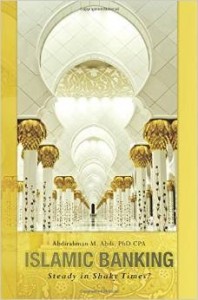By Dr. Abdirahman Mohamed Abdi Hashi
Editor’s Note: The Origins and Evolution of Islamic Law and Finance, is a chapter from the book- Islamic Banking: Steady in Shaky Times? written By Dr. Abdirahman Mohamed. Among many topics, the book examines the stability and performance of financial institutions and “if there is empirical support for the assertion that Islamic Banking are more stable than the conventional institutions”.
——-
Of all the many religions, Islam is the only one today that requires banking and other financial activities to be carried out in a way that is compatible with its laws. Other religions, such as Judaism and Christianity, have similar ethical standards, but today the concept of interest goes largely unquestioned.
 Many countries prohibited “usury” by law for many centuries. In the Middle Ages, while Catholic Canon law forbade the use of interest, this did not apply to Jews. Whilst the Torah condemns interest, this was interpreted as meaning between Jews, and Jews became renowned as moneylenders, even helping to fund many national purses. Modern conventional modes of banking date back to the industrial Revolution of more than two and half centuries ago. Up to that time, the merchants, moneylenders, and goldsmiths provided embryonic financial services.
Many countries prohibited “usury” by law for many centuries. In the Middle Ages, while Catholic Canon law forbade the use of interest, this did not apply to Jews. Whilst the Torah condemns interest, this was interpreted as meaning between Jews, and Jews became renowned as moneylenders, even helping to fund many national purses. Modern conventional modes of banking date back to the industrial Revolution of more than two and half centuries ago. Up to that time, the merchants, moneylenders, and goldsmiths provided embryonic financial services.
A. Historic Origins of Islam to the Present Prophet Mohammad (ﷺ) was born in Mecca in what is now Saudi Arabia in AD 570 into a regionally prominent tribe known as Quraysh (Jackson-Moore 2009, 2). Following the death of his father and mother, Prophet Mohammad (ﷺ) was brought up first by his grandfather Abdul-Muttalib and after his grandfather’s death, by his uncle Abu Talib.
At the age of forty, while retreating to a lonely cave on Mount Hira for solitude and contemplation during the month of Ramadan, he was shaken to find himself in the presence of the angel Gabriel, who ordered him to recite words. Angel Gabriel began to appear to the Prophet on a regular basis. Gradually, Prophet Mohammad (ﷺ) gathered around him a small band of followers, but his tribe, Quraysh, became very hostile to him since he preached for people to abandon their worship of idols and instead worship only the one God.
Eventually, Quraysh persecuted Prophet Mohammad (ﷺ) and his followers, and when the persecution became too severe, the Prophet and his followers left Mecca and migrated to Medina, where the inhabitants welcomed them. This was in AD 622, and the year of migration (hijrah) marks the first year of the Muslim calendar, which is represented by the letters “AH” (after hijrah).
Prophet Mohammad (ﷺ) lived between the years AD 570 and 632, which is approximately some fifteen centuries ago. The major division in Islam would occur as a result of political differences over whether the leader of the Muslim community should always be a descendent of the family of Ali ibn Abu Talib (AD 595–660), the Prophet’s cousin, or not. This gave birth to the Shi’a sect of Islam (this will be discussed in greater detail later in the chapter).
After the Prophet’s death in AD 632, the leadership of the Muslim community passed to his great friend and companion, Abu Bakr, the first of the four “rightly guided” caliphs (successors of the Prophet) (Hallaq 1997). Over the next five hundred years, Islam continued to expand through sub-Saharan Africa and Asia Minor, and through the Moors to Southern Spain.
Bernard Lewis, author of What Went Wrong? Western Impact & Middle Eastern Response notes that Islamic power was at its peak from the ninth through to the thirteenth centuries. During this era, Islam represented “the greatest military power on earth—its armies, at the very same time, were invading Europe and Africa, India and China. It was the foremost economic power in the world [and] it had achieved the highest level so far in human history in the arts and sciences of civilizations.”p.6.
The extraordinary enterprise represented by Muslim scholarship, science, religion, and commerce probably reached its highest level of achievement at the end of the fifteenth century; the reversal since that time has been quite remarkable (Lewis, D. L. 2008). From around the middle of the sixteenth century, Islamic learning began to be superseded by a dramatic growth of knowledge in the West.
Read more: The Origins and Evolution of Islamic Law and Finance
—–
Dr. Abdirahman is an economist and a financial expert with nearly thirty years of experience working in Wall Street and the World Bank. Dr. Abdirahman was a candidate for the president of Somalia in 2012. He currently works as a financial and economic consultant.
Dr. Abdirahman Mohamed Abdi Hashi
Email:[email protected]
twitter:Badbaado_Qaran
The Book Islamic Banking: Steady in Shaky Times? is available at AMAZON and www.IslamicBanking-Abdi.com
We welcome the submission of all articles for possible publication on WardheerNews.com. WardheerNews will only consider articles sent exclusively. Please email your article today . Opinions expressed in this article are those of the author and do not necessarily reflect the views of WardheerNews.
WardheerNew’s tolerance platform is engaging with diversity of opinion, political ideology and self-expression. Tolerance is a necessary ingredient for creativity and civility.Tolerance fuels tenacity and audacity.
WardheerNews waxay tixgelin gaara siinaysaa maqaaladaha sida gaarka ah loogu soo diro ee aan lagu daabicin goobo kale. Maqaalkani wuxuu ka turjumayaa aragtida Qoraaga loomana fasiran karo tan WardheerNews.
Copyright © 2024 WardheerNews, All rights reserved


